高中英语宾语补足语用法总结
- 格式:docx
- 大小:19.41 KB
- 文档页数:2

高中英语学习资料madeofjingetieji3.过去分词作宾语补足语可以接过去分词作宾补的动词有以下两类:A) 表示感觉或心理状态的动词.如 :see, watch, observe, look at, hear, listen to, feel, notice, think 等.I heard the song sung in English.我听到有人用英语唱过这首歌She found the door closed.B)表示 "致使 "意义的动词 .如 :have, make, get, keep, leave 等比方:He’ s going to have his hair cut.I must get my bike repaired.He was trying to make himself understood.注意:使役动词have 接过去分词作宾补有两种情况.1.过去分词所表示的动作由别人完成 . (1) He had his money stolen. 他的钱给偷了 .( 被别人偷去了 )2.过去分词所表示的动作由句中的主语所经历 .如 : (2) He had his leg broken. 他的腿断了 . ( 自己的经历 )4.过去分词作状语过去分词作状语时其逻辑主语为主句的主语 ,此时应注意人称一致,即二者是被动关系。
这跟现在分词作状语正好相反。
表示被动的和完成的动作修饰谓语,说明动作发生的背景或情况。
如:Given another hour, I can also work out this problem.再给我一个小时,我也能解这道题.(given 为过去分词作状语,它的逻辑主语为主句主语I ,即 I 被再给一个小时.)Seen from the top of the hill, the city looks more beautiful to us.从山顶看城市,城市显得更漂亮 .(seen 为过去分词作状语 ,表 " 被看 ",由语境可知 ,它的逻辑主语必定是城市 ,而不是 " 我们 ", 因为" 我们 " 应主动看城市 .)A)作时间状语,相当于一个时间状语从句。

高中英语高频结构:with的复合结构句型:“with+宾语+宾语补足语”复合结构“With+ 复合结构”又称为“with结构”,在句中表状态或说明背景情况,常做伴随,方式,原因,条件等状语。
常见形式有:1. with+宾语+形容词(强调宾语的特性或状态)①She often sleeps with the windows open.她常开着窗睡觉。
②You shouldn’t speak with your mouth full.你不应该满嘴巴食物说话。
③With the weather so close and stuffy, ten to one it'll rain presently. 天气这么闷热,十之八九要下雨。
2.with+宾语+副词①He stood before his teacher with his head down. 他低着头站在老师面前。
②He was lying on the bed with all his clothes on. 他穿着衣服躺在床上。
③With John away, we've got more room.随着约翰离开,我们有更多的空间。
3. with+宾语+名词①He died with his daughter yet a schoolgirl. 他去世时,女儿还是个小学生。
②He left home,with his wife a hopeless soul. 他走了,妻子十分伤心。
4.with+宾语+介词短语①She said good-bye with tears in her eyes. 她含着眼泪说了声再见。
②He was asleep with his head on his arms. 他头枕着胳膊睡着了。
③The teacher entered the classroom with a book in his hand.老师手里拿着一本书走进教室。
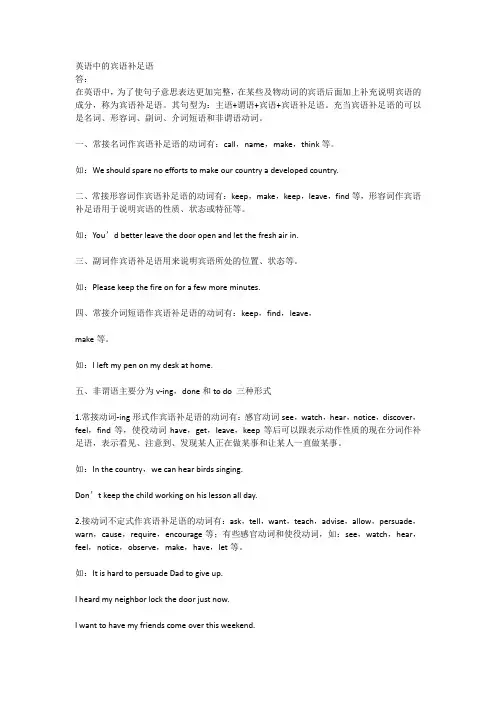
英语中的宾语补足语答:在英语中,为了使句子意思表达更加完整,在某些及物动词的宾语后面加上补充说明宾语的成分,称为宾语补足语。
其句型为:主语+谓语+宾语+宾语补足语。
充当宾语补足语的可以是名词、形容词、副词、介词短语和非谓语动词。
一、常接名词作宾语补足语的动词有:call,name,make,think等。
如:We should spare no efforts to make our country a developed country.二、常接形容词作宾语补足语的动词有:keep,make,keep,leave,find等,形容词作宾语补足语用于说明宾语的性质、状态或特征等。
如:You’d better leave the door open and let the fresh air in.三、副词作宾语补足语用来说明宾语所处的位置、状态等。
如:Please keep the fire on for a few more minutes.四、常接介词短语作宾语补足语的动词有:keep,find,leave,make等。
如:I left my pen on my desk at home.五、非谓语主要分为v-ing,done和to do 三种形式1.常接动词-ing形式作宾语补足语的动词有:感官动词see,watch,hear,notice,discover,feel,find等,使役动词have,get,leave,keep等后可以跟表示动作性质的现在分词作补足语,表示看见、注意到、发现某人正在做某事和让某人一直做某事。
如:In the country,we can hear birds singing.Don’t keep the child working on his lesson all day.2.接动词不定式作宾语补足语的动词有:ask,tell,want,teach,advise,allow,persuade,warn,cause,require,encourage等;有些感官动词和使役动词,如:see,watch,hear,feel,notice,observe,make,have,let等。
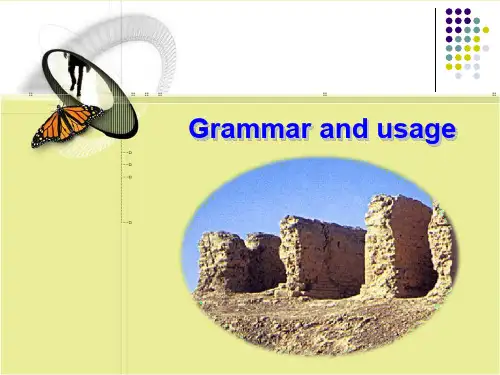
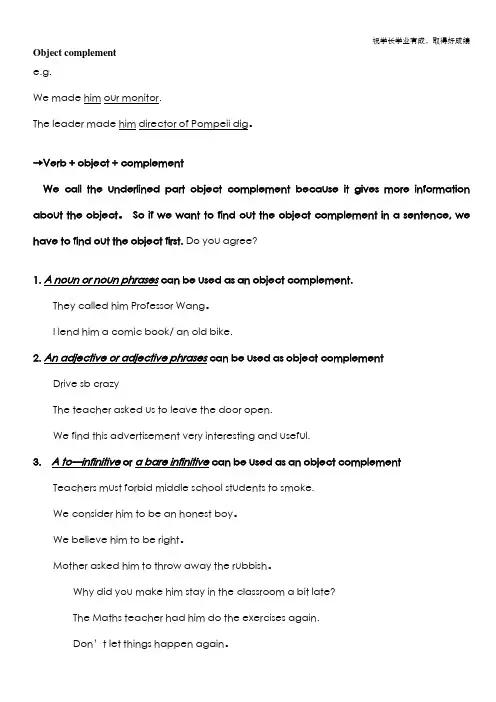
Object complemente.g.We made him our monitor.The leader made him director of Pompeii dig。
→Verb + object + complementWe call the underlined part object complement because it gives more information about the object。
So if we want to find out the object complement in a sentence, we have to find out the object first. Do you agree?1. A noun or noun phrases can be used as an object complement.They called him Professor Wang。
I lend him a comic book/ an old bike.2. An adjective or adjective phrases can be used as object complementDrive sb crazyThe teacher asked us to leave the door open.We find this advertisement very interesting and useful.3. A to—infinitive or a bare infinitive can be used as an object complementTeachers must forbid middle school students to smoke.We consider him to be an honest boy。
We believe him to be right。
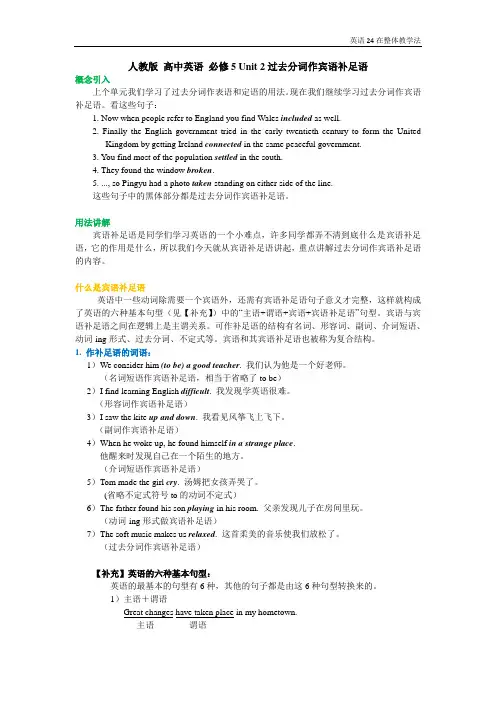
人教版高中英语必修5 Unit 2过去分词作宾语补足语概念引入上个单元我们学习了过去分词作表语和定语的用法。
现在我们继续学习过去分词作宾语补足语。
看这些句子:1. Now when people refer to England you find Wales included as well.2. Finally the English government tried in the early twentieth century to form the UnitedKingdom by getting Ireland connected in the same peaceful government.3. You find most of the population settled in the south.4. They found the window broken.5. ..., so Pingyu had a photo taken standing on either side of the line.这些句子中的黑体部分都是过去分词作宾语补足语。
用法讲解宾语补足语是同学们学习英语的一个小难点,许多同学都弄不清到底什么是宾语补足语,它的作用是什么,所以我们今天就从宾语补足语讲起,重点讲解过去分词作宾语补足语的内容。
什么是宾语补足语英语中一些动词除需要一个宾语外,还需有宾语补足语句子意义才完整,这样就构成了英语的六种基本句型(见【补充】)中的“主语+谓语+宾语+宾语补足语”句型。
宾语与宾语补足语之间在逻辑上是主谓关系。
可作补足语的结构有名词、形容词、副词、介词短语、动词-ing形式、过去分词、不定式等。
宾语和其宾语补足语也被称为复合结构。
1. 作补足语的词语:1)We consider him (to be) a good teacher. 我们认为他是一个好老师。
(名词短语作宾语补足语,相当于省略了to be)2)I find learning English difficult. 我发现学英语很难。
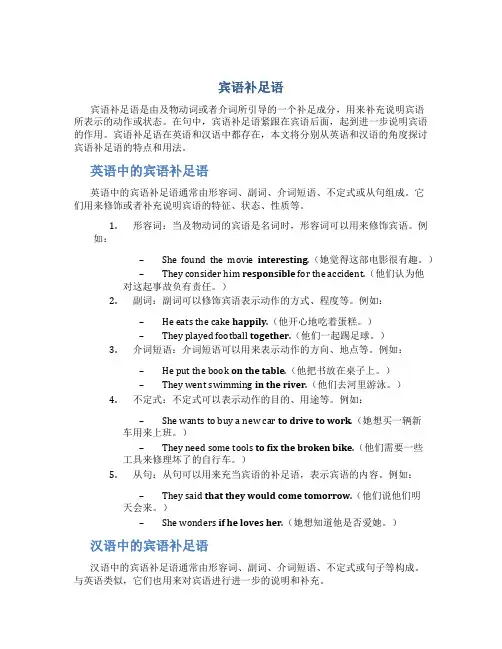
宾语补足语宾语补足语是由及物动词或者介词所引导的一个补足成分,用来补充说明宾语所表示的动作或状态。
在句中,宾语补足语紧跟在宾语后面,起到进一步说明宾语的作用。
宾语补足语在英语和汉语中都存在,本文将分别从英语和汉语的角度探讨宾语补足语的特点和用法。
英语中的宾语补足语英语中的宾语补足语通常由形容词、副词、介词短语、不定式或从句组成。
它们用来修饰或者补充说明宾语的特征、状态、性质等。
1.形容词:当及物动词的宾语是名词时,形容词可以用来修饰宾语。
例如:–She found the movie interesting.(她觉得这部电影很有趣。
)–They consider him responsible for the accident.(他们认为他对这起事故负有责任。
)2.副词:副词可以修饰宾语表示动作的方式、程度等。
例如:–He eats the cake happily.(他开心地吃着蛋糕。
)–They played football together.(他们一起踢足球。
)3.介词短语:介词短语可以用来表示动作的方向、地点等。
例如:–He put the book on the table.(他把书放在桌子上。
)–They went swimming in the river.(他们去河里游泳。
)4.不定式:不定式可以表示动作的目的、用途等。
例如:–She wants to buy a new car to drive to work.(她想买一辆新车用来上班。
)–They need some tools to fix the broken bike.(他们需要一些工具来修理坏了的自行车。
)5.从句:从句可以用来充当宾语的补足语,表示宾语的内容。
例如:–They said that they would come tomorrow.(他们说他们明天会来。
)–She wonders if he loves her.(她想知道他是否爱她。
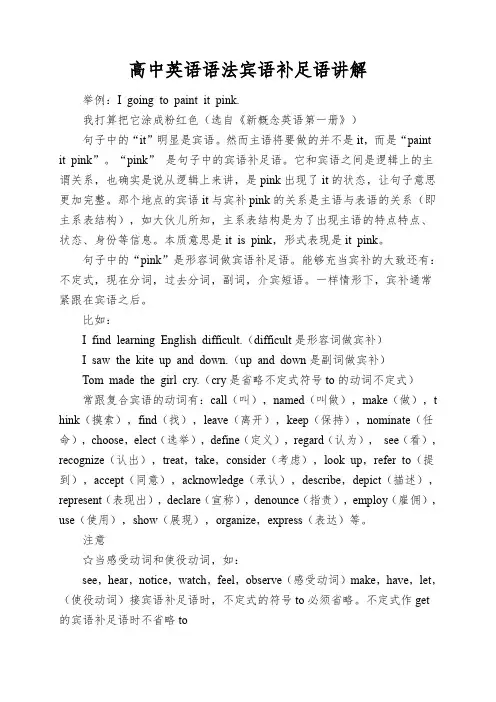
高中英语语法宾语补足语讲解举例:I going to paint it pink.我打算把它涂成粉红色(选自《新概念英语第一册》)句子中的“it”明显是宾语。
然而主语将要做的并不是it,而是“paint it pink”。
“pink”是句子中的宾语补足语。
它和宾语之间是逻辑上的主谓关系,也确实是说从逻辑上来讲,是pink出现了it的状态,让句子意思更加完整。
那个地点的宾语it与宾补pink的关系是主语与表语的关系(即主系表结构),如大伙儿所知,主系表结构是为了出现主语的特点特点、状态、身份等信息。
本质意思是it is pink,形式表现是it pink。
句子中的“pink”是形容词做宾语补足语。
能够充当宾补的大致还有:不定式,现在分词,过去分词,副词,介宾短语。
一样情形下,宾补通常紧跟在宾语之后。
比如:I find learning English difficult.(difficult是形容词做宾补)I saw the kite up and down.(up and down是副词做宾补)Tom made the girl cry.(cry是省略不定式符号to的动词不定式)常跟复合宾语的动词有:call(叫),named(叫做),make(做),t hink(摸索),find(找),leave(离开),keep(保持),nominate(任命),choose,elect(选举),define(定义),regard(认为),see(看),recognize(认出),treat,take,consider(考虑),look up,refer to(提到),accept(同意),acknowledge(承认),describe,depict(描述),represent(表现出),declare(宣称),denounce(指责),employ(雇佣),use(使用),show(展现),organize,express(表达)等。
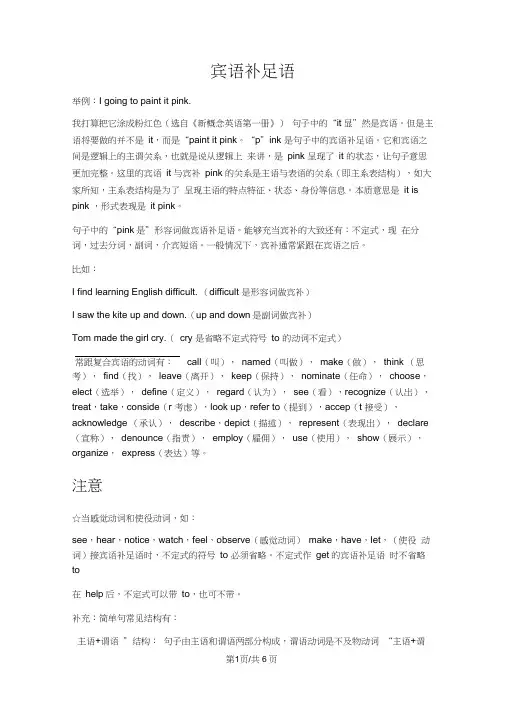
宾语补足语举例:I going to paint it pink.我打算把它涂成粉红色(选自《新概念英语第一册》)句子中的“it显”然是宾语。
但是主语将要做的并不是it,而是“paint it pink。
“p”ink 是句子中的宾语补足语。
它和宾语之间是逻辑上的主谓关系,也就是说从逻辑上来讲,是pink 呈现了it 的状态,让句子意思更加完整。
这里的宾语it 与宾补pink 的关系是主语与表语的关系(即主系表结构),如大家所知,主系表结构是为了呈现主语的特点特征、状态、身份等信息。
本质意思是it is pink ,形式表现是it pink。
句子中的“pink是”形容词做宾语补足语。
能够充当宾补的大致还有:不定式,现在分词,过去分词,副词,介宾短语。
一般情况下,宾补通常紧跟在宾语之后。
比如:I find learning English difficult. (difficult 是形容词做宾补)I saw the kite up and down.(up and down是副词做宾补)Tom made the girl cry.(cry 是省略不定式符号to 的动词不定式)常跟复合宾语的动词有:call(叫),named(叫做),make(做),think (思考),find(找),leave(离开),keep(保持),nominate(任命),choose,elect(选举),define(定义),regard(认为),see(看),recognize(认出),treat,take,conside(r 考虑),look up,refer to(提到),accep(t 接受),acknowledge (承认),describe,depict(描述),represent(表现出),declare (宣称),denounce(指责),employ(雇佣),use(使用),show(展示),organize,express(表达)等。

Section ⅢGrammar——宾语补足语、either...or...和neither...nor...的用法以及主谓一致一、宾语补足语英语中句子的宾语需要进一步补充说明时,其后常接补充成分,称为宾语补足语。
可以充当宾语补足语的有:名词、形容词、副词、动词不定式、现在分词、过去分词、介词短语等。
1.名词作宾语补足语能以名词作宾语补足语的动词有:name,call,appoint,find,consider,choose,elect,think,leave,keep等。
They named their child John.他们给孩子取名为约翰。
We made her monitor of our class.我们选她做班长。
[名师点津]表示头衔或职务的名词作宾语补足语时,名词前不加冠词。
2.形容词作宾语补足语形容词作宾语补足语,主要用于表示宾语所处的状态或某一动作的结果,可以接形容词作宾语补足语的动词有:make,prove,leave,find,think,consider,keep 等。
She was determined to prove everyone wrong.她决心证明大家都是错的。
3.副词作宾语补足语某些副词可用于动词或介词 with和without 后作宾语补足语,作宾语补足语的副词多用于表示动作或动作的方向等。
可以充当宾语补足语的副词有:out,upstairs,in,over,on,outside,indoors等。
The woman walked along the river up and down with her head down.那位女士低着头,沿着河岸踱来踱去。
4.介词短语作宾语补足语介词短语作宾语补足语时,可用于表示状态、职位、身份、地位等。
She found the machine in good condition.她发现那台机器状况良好。
A conceited man always thinks himself above others.自负者总认为自己高人一等。
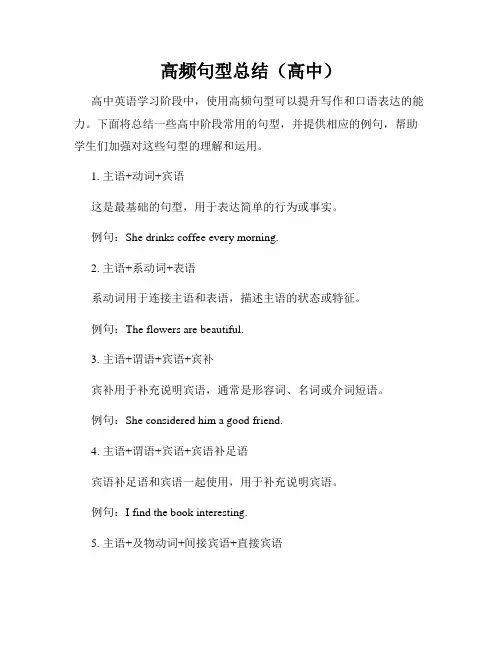
高频句型总结(高中)高中英语学习阶段中,使用高频句型可以提升写作和口语表达的能力。
下面将总结一些高中阶段常用的句型,并提供相应的例句,帮助学生们加强对这些句型的理解和运用。
1. 主语+动词+宾语这是最基础的句型,用于表达简单的行为或事实。
例句:She drinks coffee every morning.2. 主语+系动词+表语系动词用于连接主语和表语,描述主语的状态或特征。
例句:The flowers are beautiful.3. 主语+谓语+宾语+宾补宾补用于补充说明宾语,通常是形容词、名词或介词短语。
例句:She considered him a good friend.4. 主语+谓语+宾语+宾语补足语宾语补足语和宾语一起使用,用于补充说明宾语。
例句:I find the book interesting.5. 主语+及物动词+间接宾语+直接宾语间接宾语在句中表示接受动作的人或事物,直接宾语表示动作的对象。
例句:He gave me a present.6. 主语+及物动词+间接宾语+直接宾语+宾语补足语在含有间接宾语和直接宾语的句子中,宾语补足语用于补充说明直接宾语。
例句:They made him their team leader.7. 主语+及物动词+直接宾语+宾补+宾语补足语宾补和宾语补足语结合使用,用于补充说明直接宾语。
例句:I consider the movie a masterpiece.8. 主语+不及物动词不及物动词没有宾语,只有主语和谓语。
例句:He runs every morning.9. 主语+系动词+表语+表语补足语表语补足语和表语一起使用,用于补充说明表语。
例句:She is a teacher by profession.10. 强调句型这种句型用于强调句子中的某个成分,通常使用“it is/was...that...”的结构。
例句:It was in the library that I found the book I was looking for.11. 虚拟语气虚拟语气用于表达假设、愿望、建议、要求等内容,常常使用“should/could/would/might”等情态动词。
高中英语必修二Unit 4过去分词作定语和宾语补足语精讲一、过去分词作定语1.意义:及物动词的过去分词作定语往往表示被动和完成;不及物动词的过去分词作定语不表示被动,只表示完成。
(1)表示被动和完成a polluted river一条被污染的河流the watered flowers浇过水的花(2)只表示完成,不表示被动fallen leaves落叶the risen sun升起的太阳2.位置:单个的过去分词作定语时,通常放在被修饰词的前面;过去分词短语作定语时,通常放在被修饰词的后面,其作用相当于一个定语从句。
The student dressed in white is my daughter.=The student who is dressed in white is my daughter.穿白色衣服的那个学生是我女儿。
注意:过去分词作定语和现在分词作定语的区别:(1)语态不同:现在分词表示主动;过去分词表示被动。
The question discussedwas very important.讨论过的那个问题很重要。
The house standing at thecorner of the street was built in 2016.矗立在街道角落的那所房子是2016年建的。
(2)时间关系上不同:现在分词表示动作正在进行;过去分词表示动作已经完成。
3.过去分词(done)、现在分词的被动语态(being done)与动词不定式的被动语态(to be done)意义形式语态时态done 被动完成being done 被动进行to be done 被动尚未发生去年建造的楼是我们的教学楼。
The buildingbeing built now is our classroombuilding.现在正在建造的楼是我们的教学楼。
The buildingto be built next month is ourclassroom building.下个月将要建造的楼是我们的教学楼。
unit 6一、要点语法知识:1.此刻分词作宾语补足语:(1)位于感官动词后:see,hear,feel,smell,watch,catch(就地发现) find,listen to ,look at ,notice ,observe 后跟 doing 表示动作正在进行,后跟 do 表示动作的全过程 see sb. doing sth看.到某人正在做某事(看到动作正在进行) see sb. do sth看.到某人做某事(看到动作全过程)(2)位于使役动词后:set,keep,have,get, leave 等过去分词作宾语补足语:(1)用于表示某种状态的动词keep, leave 等( 2)have/get+宾语 +过去分词表示让他人做某事或遭受某种不幸(3)make+宾语+过去分词表示结果( 4)位于感官动词后: see,hear,feel,smell,watch,catch (就地发现) find, listen to ,look at ,notice ,observe 后表示被动达成的动作(5)在 with+ 宾语 +过去分词构造中,宾语与过去分词之间是被动关系。
动名词作主语: doing 作主语表示一般或抽象的多次行为, to do 作主语表示详细的一次性的动作。
动名词作主语常用 it 作形式主语。
常用于固定句型中: It is no use/good doing sth.2.the number of-------的数目,谓语用单数 a number of 大批的,谓语用复数the majority of+ 复数名词,谓语用复数 a majority of+复数名词,谓语用复数 a large amount of+不行数名词,谓语用单数 large amounts of+不行数名词,谓语用复数3.as 指引时间状语从句:跟着,当---时;指引原由状语从句:因为,因为;指引方式状语从句:正如---;指引退步状语从句:只管,固然;指引比较状语从句:和 ---同样 ---;指引定语从句:作关系代词,正如,常用于被动4.the+比较级---,the+比较级---越---,就越---;愈来愈---:比较级+and+比较级;more and more+多音节形容词原级。
高考一轮复习 非谓语做宾语补足语part 1 知识梳理常见形式有:to do 、doing 、done 。
一般而言,被动形式用done ,主动形式用to do 或者doing 。
例如: 1. As I approached mile 23, I could see my wife waving a sign .(2018年北京卷) 当我接近23英里时,我能看到妻子正拿着标牌在晃动(主动,正在)。
2. Last Tuesday, our class invited an old craftsman(手艺人) to teach us how to make dough figurines(面人). 上周二,我们班邀请一位老艺人教我们怎样制作面人(主动,事实陈述)。
3. I have never heard this song sung in English . 我从来没有听到这首歌用英语唱过(被动)。
(一) 省略to 做宾补的(1)形式:动词跟省略to 的不定式作宾补时,通常包括两大类,感官动词类(8个,look at ;see ;observe ;watch ;notice ;hear ;listen to ;feel ),使役动词类(3个have ;let ;make )。
(2)含义:省略to 做宾补的强调看到、听到了整个过程或强调是事实。
不过感官动词后也可跟现在现在分词作宾语,表示看到、听到时动作正在进行,have 后可以加doing (含义见后边),但是let ,make 后不可跟现在分词做宾语 接不带to 的不定式做宾补(3)宾语感官动词(短语)see ,watch ,observe ,look at ,notice ,hear ,listen to ,feel 等的宾语补足语主要有三种形式,试比较(以hear 为例):hear +宾语+⎩⎪⎨⎪⎧doing sth.听到……正在做……(主动、进行)do sth.听到……做了……(主动、完成)done 听到……被做(被动、完成或无时间性)a )I felt somebody touch the box . (整个过程或事实)我感觉到有人碰了这个盒子。
人教版高中英语必修四知识点梳理重点题型(常考知识点)巩固练习动词ing形式作表语,定语和宾语补足语概念引入:The music they are playing sounds so exciting .We watched three boys sharing their food with eachOur job is playing all kinds of music .The girl singing now is a classmate of mine语法讲解【356774 ,非谓语动词之-ing形式,非谓语动词之ing形式】非谓语动词中的ing形式包括两种:一种是动名词,另外一种是现在分词。
•基本形式:1、-ing形式作表语1) -ing形式作表语时放在系动词之后,用来泛指某种动作或行为,以说明主语的具体内容(身份、性质或情况)。
如:Her hobby is painting.她的业余爱好是画画。
My job is looking after the children.我的工作就是照顾这些孩子。
2) –ing用来表示主语所具有的特征,如:His concern for his mother is most touching.他对母亲的关爱很感人。
His words are encouraging.他的话很鼓舞人。
2、-ing形式作定语1). 说明被修饰名词的作用和用途,如:building materials= materials for building 建筑材料drinking water= water for drinking 饮用水a reading room= a room for reading 阅览室2). 说明被修饰名词的作用和用途,如:tiring music= music that is tiring 烦人的音乐a surprising result= a result that is surprising一个惊人的结果3). 表示被修饰名词正在进行的动作,如:正在做实验的那个学生是我们的班长。
宾语补足语
一、定义
某些及物动词的宾语后面还需要有一个补足语,意思才完整。
宾语补足语说明宾语的情况、性质、特征、状态、身份或属类等。
宾语和它的补足语构成复合宾语。
二、可作宾语补足语的形式
不定式,现在分词,过去分词,名词,形容,副词,介词短语都能作宾语补足语。
eg:We made him our monitor.
You should keep your room clean and tidy.
We could hear the children playing outside.
I left my pen on my desk at home.
I saw the kite up and down.
She often asks me to help her.
三、常接宾语补足语的动词
1. 常接形容词作宾语补足语的动词有:keep, make, find等。
eg:We must keep our classroom clean.
I found the book very interesting.
2. 常接名词作宾语补足语的动词有:含命名意义的动词call, name, make, think等。
eg:We call them mooncakes.
She found him a very clever boy.
My mother looks so young that they would think her my sister
3. 常接介词短语作宾语补足语的动词有:keep, find, leave等。
eg:I left my pen on my desk at home.
I found everything in good condition.
4. 动词不定式作宾语补足语表示动作的全过程或即将发生的主动动作
(1)常接带to的动词不定式作宾语补足语的动词有:ask, tell, want, teach, wish, expect, remind, warn, encourage, allow, order 等
eg : sMy teacher told me to focus on my study.
I expect my students to have made preparations for the mid-term examinations.
(2)接不带to的动词不定式作宾语补足语的动词有:一感二听三让四观看
一感:feel
二听:hear, listen to
三让:let, have, make
四观看:observe, see, watch, look at
【注意】在被动语态中不带to的不定式前要补加上to)
eg : Professor Zhang’s speech made us all laugh.
I heard Justin put on his favorite CD.
5. V-ing形式作宾语补足语,表示宾语是动作的发出者,形成逻辑上的主谓关系,表示的是一个正在进行的主动动作。
eg : The bad news kept him sleeping poorly.
They watched the bird flying in the sky.
6. V-ed形式作宾语补足语表示宾语是动作的承受者,构成逻辑上的动宾关系,表示一个已经完成或被动的动作.s
eg: I found a girl knocked down by a car.
I had my computer repaired.
【注意】 have + 宾语+done的几种含义
①“主语请别人做某事”。
He wants to have his eyes examined tomorrow.
②“主语遭遇、遭受某一不愉快、不测的事情”。
Be careful, or you'll have your hands hurt.
She had her wallet stolen yesterday.s
③“使完成某事”,事情既可以是别人做完,也可以由主语参与完成。
He had the walls painted this morning.
他今早把墙漆了。
(主语自己可能参与)
I have had all my spelling mistakes corrected.。